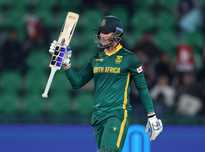Suryakumar Yadav, the celebrated cricketer, recently underwent surgery in Europe to address a sports hernia. The 34-year-old shared the update on his Instagram, expressing optimism for a swift recovery. This raises a crucial question: What exactly is a sports hernia, and how does it differ from a regular hernia? Let's delve into the details.

A sports hernia, clinically known as athletic pubalgia, is a painful injury affecting the soft tissues in the lower abdomen or groin area. Unlike a traditional hernia, a sports hernia doesn't present as a visible bulge. Instead, it involves tears or strains in the muscles, tendons, or ligaments surrounding the groin, resulting in persistent pain that intensifies with sudden movements.
Athletes who engage in sports that demand sudden directional changes, twisting motions, or intense forceful movements are particularly susceptible to sports hernias. Cricket, soccer, football, hockey, and wrestling are prime examples. In contrast to an inguinal hernia, where an organ or tissue protrudes through a weakened muscle, a sports hernia involves muscular or tendinous damage without any visible protrusion. This makes diagnosis challenging, but the pain and discomfort experienced, especially during physical activity, are significant.
The primary symptom of a sports hernia is pain in the groin or lower abdomen. This pain can manifest abruptly during an injury or develop gradually over time due to repetitive movements. Key symptoms include:

Due to the absence of a bulge and the diffused nature of the pain, pinpointing the exact location of the hernia can be difficult. The injury may also lead to stiffness and soreness post-exercise, hindering athletic performance.
A sports hernia is typically caused by repetitive movements that strain the muscles and tendons in the lower abdomen and groin. The injury occurs when these soft tissues are stretched or torn due to sudden twisting of the pelvis.
Common causes include:
Treatment for a sports hernia varies depending on the severity of the injury. Possible treatments include:
Avoiding activities that trigger pain, especially twisting and sudden movements, promotes tissue healing. However, this process can be lengthy.

A structured rehabilitation program focuses on strengthening the abdominal and hip muscles, enhancing flexibility, and correcting muscle imbalances. Physical therapy is often the initial approach.
Nonsteroidal anti-inflammatory drugs (NSAIDs) can alleviate pain and inflammation, although they do not address the underlying issue.
If symptoms persist despite conservative treatments, surgery may be necessary to repair the torn tissues. Surgical options include repairing or reinforcing the damaged tendons and muscles around the pubic bone. Surgery generally leads to successful recovery and a gradual return to sports activities.
Newer articles
Older articles
 Indian Astronaut Joins ISS: Shukla's Mission Ushers in New Era for India's Space Program
Indian Astronaut Joins ISS: Shukla's Mission Ushers in New Era for India's Space Program
 Ashada Gupt Navratri 2025: Unveiling Dates, Sacred Rituals & Hidden Significance
Ashada Gupt Navratri 2025: Unveiling Dates, Sacred Rituals & Hidden Significance
 Rishabh Pant's Unconventional Batting Redefining Cricket, Says Greg Chappell
Rishabh Pant's Unconventional Batting Redefining Cricket, Says Greg Chappell
 Moto G54 Price Slashed in India: Check Out the New, Lower Cost
Moto G54 Price Slashed in India: Check Out the New, Lower Cost
 JPG to PDF: A Graphic Designer's Guide to File Conversion and Quality Preservation
JPG to PDF: A Graphic Designer's Guide to File Conversion and Quality Preservation
 'The Traitors' Star Apoorva Mukhija Accuses Sudhanshu Pandey of Misogyny and Verbal Abuse After On-Screen Drama
'The Traitors' Star Apoorva Mukhija Accuses Sudhanshu Pandey of Misogyny and Verbal Abuse After On-Screen Drama
 Van der Dussen to Captain South Africa in T20I Tri-Series Against New Zealand and Zimbabwe
Van der Dussen to Captain South Africa in T20I Tri-Series Against New Zealand and Zimbabwe
 20 Minutes to a Healthier Brain and Heart: Neurologist's Simple Strategies to Combat Cholesterol, Blood Pressure, and Dementia Risk
20 Minutes to a Healthier Brain and Heart: Neurologist's Simple Strategies to Combat Cholesterol, Blood Pressure, and Dementia Risk
 England's Audacious Batters Claim They Could Have Chased Down 450 in First Test Win Over India
England's Audacious Batters Claim They Could Have Chased Down 450 in First Test Win Over India
 Popular Finance YouTuber "financewithsharan" Hacked: Security Measures to Protect Your Account
Popular Finance YouTuber "financewithsharan" Hacked: Security Measures to Protect Your Account